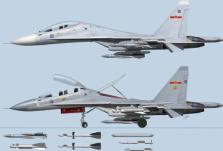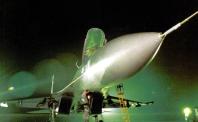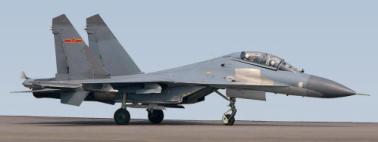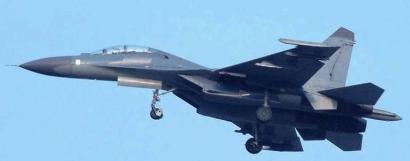| |
|
|
Application in Aviation
Introduction of J-11 Aircraft Fighter

View in Large Size
The J-11 (Jianji-11 or Jian-11) is a licensed copy of the Russian Sukhoi Su-27SK air-superiority fighter aircraft built by Shenyang Aircraft Corporation (SAC). The initial batches of the J-11 were identical to the single-seat Su-27SK, but the later batches had increased portion of Chinese-made components. SAC is currently developing an “indigenised” upgraded variant known as J-11B, which was based on the J-11/Su-27SK airframe but equipped with Chinese-developed avionics and weapon suite. SAC is also planning to power future productions of the J-11 with the indigenous WS-10A turbofan engine.
 The People’s Republic of China (PRC) became the first non-CIS country to operate the Su-27SK and Su-27UBK fighters in the early 1990s. In 1995, Russian agreed in principle to allow the PRC to build the Su-27SK single-seat fighter locally under license. In 1996, Sukhoi Company (JSC) and SAC entered into a contract worth US$2.5 billion for the co-production of 200 Su-27SK fighters as the J-11. Under the terms of the agreement, Sukhoi/KnAAPO would supply the aircraft in kit form to be assembled in SAC. It was reported that Russia also agreed to help the PRC gradually increase the portion of Chinese-made content on the J-11, so that SAC could eventually produce the aircraft interpedently. The People’s Republic of China (PRC) became the first non-CIS country to operate the Su-27SK and Su-27UBK fighters in the early 1990s. In 1995, Russian agreed in principle to allow the PRC to build the Su-27SK single-seat fighter locally under license. In 1996, Sukhoi Company (JSC) and SAC entered into a contract worth US$2.5 billion for the co-production of 200 Su-27SK fighters as the J-11. Under the terms of the agreement, Sukhoi/KnAAPO would supply the aircraft in kit form to be assembled in SAC. It was reported that Russia also agreed to help the PRC gradually increase the portion of Chinese-made content on the J-11, so that SAC could eventually produce the aircraft interpedently.
The first kit-built J-11 rolled out at SAC in December 1998, but the full-scale production did not commence until 2000 due to technical problems. Russian sources confirmed that 48 aircraft had been produced by 2002, and another 48 between 2002 and 2003. However, SAC hinted as early as 2000 that not all 200 J-11s would be built. In November 2004, Russian media reported that the J-11 production had stopped after about 100 examples were built. According to the report, the Chinese side had requested Sukhoi Company to stop deliveries of the assembly kits. The report citing a source within the PLAAF suggested that the basic variant Su-27SK/J-11 no longer met the PLAAF requirements.
 A number of reasons may have contributed to the stop of the J-11 production. Firstly, the co-production agreement did not include the transfer of avionics and engine technologies, and the Chinese-built J-11 would have to continue relying on the Russian supply of these systems. Secondly, the Russian-made fire-control system on the J-11 is not compatible with the Chinese missiles. As a result, the PLAAF had to import additional R-27 (AA-10) MRAAM and R-73 (AA-11) SRAAM from Russia to support the operations of its J-11s. Thirdly, as a single mission air superiority fighter, the Su-27SK/J-11 could only perform secondary attack missions, and only with “dumb” munitions that include a range of free-fall bombs and unguided rockets. A number of reasons may have contributed to the stop of the J-11 production. Firstly, the co-production agreement did not include the transfer of avionics and engine technologies, and the Chinese-built J-11 would have to continue relying on the Russian supply of these systems. Secondly, the Russian-made fire-control system on the J-11 is not compatible with the Chinese missiles. As a result, the PLAAF had to import additional R-27 (AA-10) MRAAM and R-73 (AA-11) SRAAM from Russia to support the operations of its J-11s. Thirdly, as a single mission air superiority fighter, the Su-27SK/J-11 could only perform secondary attack missions, and only with “dumb” munitions that include a range of free-fall bombs and unguided rockets.
PLAAF J-11 '80 Blue' (Chinese Internet)
Sukhoi Company JSC actively marketed its Su-27SKM to the PRC in 2003. The Su-27SKM was a modernised multi-role variant derived from the Su-27SK, but with an improved Zhuk-27 (or N001VEP on the later variant) fire-control radar, and an upgraded cockpit featuring multifunctional displays similar to that of the Su-30MK. However, the aircraft was rejected by the PLAAF in favour of an ‘indigenised’ variant of the J-11.
J-11B
In mid-2002, SAC revealed its intention to build an upgraded multirole version of the J-11 by revealing a mock-up aircraft carrying various types of air-to-air and air-to-surface missiles. Russian sources also confirmed that SAC was pursuing a multirole variant of the J-11 with much greater Chinese-made content. This variant was designated J-11B.
At least three examples (#523, #524, and #525) of the J-11B have been delivered to the China Flight Test Establishment (CFTE) for flight test and evaluation since 2006. The aircraft was based on the Su-27SK/J-11 airframe, but with the following modifications:
An indigenous multifunctional pulse-Doppler fire-control radar reportedly capable of tracking 6~8 targets and engaging 4 of them simultaneously;
An indigenous digital flight-control system;
A Chinese copy of the Russian OEPS-27 electro-optic search and tracking system;
A strapdown INS/GPS navigation system;
A ‘glass’ cockpit featuring four colour multifunctional displays (MFD) and a wide-angle holographic head-up display (HUD);
J-11B prototype (Chinese Internet)
J-11B fighter carrying an indigenous PL-8 SRAAM (Chinese Internet)
 The aircraft could carry the Chinese-made PL-8 IR-homing SRAAM and PL-12 (SD-10) active radar-homing MRAAM for air-to-air combat. While the PLAAF currently has the capability for two-target engagement using the Su-27/-30 and R-77 (AA-12 Adder) combination, successful integration of the PL-12 on the J-11B would likely provide a genuine multi-target engagement capability. The J-11B is also expected to have enhanced air-to-surface attack capabilities with the indigenous precision strike ammunitions such as LT-2 laser-guided bomb, the LS-6 precision-guided glide bomb, the YJ-91 (Kh-31P) anti-radiation missile, and the KD-88 air-to-surface missile. The aircraft could carry the Chinese-made PL-8 IR-homing SRAAM and PL-12 (SD-10) active radar-homing MRAAM for air-to-air combat. While the PLAAF currently has the capability for two-target engagement using the Su-27/-30 and R-77 (AA-12 Adder) combination, successful integration of the PL-12 on the J-11B would likely provide a genuine multi-target engagement capability. The J-11B is also expected to have enhanced air-to-surface attack capabilities with the indigenous precision strike ammunitions such as LT-2 laser-guided bomb, the LS-6 precision-guided glide bomb, the YJ-91 (Kh-31P) anti-radiation missile, and the KD-88 air-to-surface missile.
During the 6th Zhuhai Air Show held between 31 October and 5 November 2006, China revealed first official details about the indigenously developed WS-10A ‘Tai Hang’ turbofan engine. The engine had already been successfully tested on a modified Su-27K fighter and possibly on some J-11 airframes too. The engine is understood to be similar to the Russian Lyulka-Saturn AL-31F turbofan engine in both technology and performance. However, it is unclear whether the WS-10A has already been fitted on the 'indigenised' variant of the J-11.
The multifunctional pulse-Doppler fire-control radar of the J-11B is seen here being tested on a specially modified Y-8 testbed '079' belonging to the CFTE (Chinese Internet)
A PLAAF test pilot with a Russian-style helmet sits in the J-11B cockpit (Chinese Internet)
J-11BS
There has been speculation that Shenyang is currently developing a two-seater version of the J-11B, possibly designated J-11BS. The aircraft was said to be similar to the Su-27UBK fighter-trainer, but fitted with Chinese-made powerplant, avionics, and weapon suite.
|
|
|